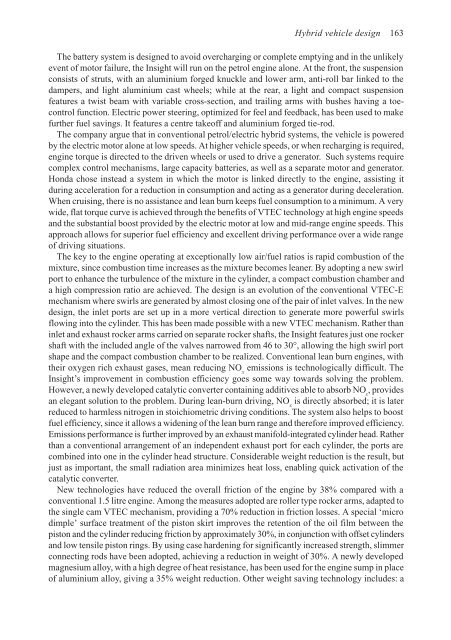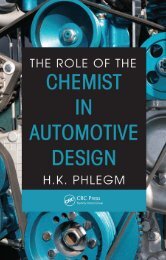Lightweight Electric/Hybrid Vehicle Design
Lightweight Electric/Hybrid Vehicle Design
Lightweight Electric/Hybrid Vehicle Design
You also want an ePaper? Increase the reach of your titles
YUMPU automatically turns print PDFs into web optimized ePapers that Google loves.
<strong>Hybrid</strong> vehicle design 163<br />
The battery system is designed to avoid overcharging or complete emptying and in the unlikely<br />
event of motor failure, the Insight will run on the petrol engine alone. At the front, the suspension<br />
consists of struts, with an aluminium forged knuckle and lower arm, anti-roll bar linked to the<br />
dampers, and light aluminium cast wheels; while at the rear, a light and compact suspension<br />
features a twist beam with variable cross-section, and trailing arms with bushes having a toecontrol<br />
function. <strong>Electric</strong> power steering, optimized for feel and feedback, has been used to make<br />
further fuel savings. It features a centre takeoff and aluminium forged tie-rod.<br />
The company argue that in conventional petrol/electric hybrid systems, the vehicle is powered<br />
by the electric motor alone at low speeds. At higher vehicle speeds, or when recharging is required,<br />
engine torque is directed to the driven wheels or used to drive a generator. Such systems require<br />
complex control mechanisms, large capacity batteries, as well as a separate motor and generator.<br />
Honda chose instead a system in which the motor is linked directly to the engine, assisting it<br />
during acceleration for a reduction in consumption and acting as a generator during deceleration.<br />
When cruising, there is no assistance and lean burn keeps fuel consumption to a minimum. A very<br />
wide, flat torque curve is achieved through the benefits of VTEC technology at high engine speeds<br />
and the substantial boost provided by the electric motor at low and mid-range engine speeds. This<br />
approach allows for superior fuel efficiency and excellent driving performance over a wide range<br />
of driving situations.<br />
The key to the engine operating at exceptionally low air/fuel ratios is rapid combustion of the<br />
mixture, since combustion time increases as the mixture becomes leaner. By adopting a new swirl<br />
port to enhance the turbulence of the mixture in the cylinder, a compact combustion chamber and<br />
a high compression ratio are achieved. The design is an evolution of the conventional VTEC-E<br />
mechanism where swirls are generated by almost closing one of the pair of inlet valves. In the new<br />
design, the inlet ports are set up in a more vertical direction to generate more powerful swirls<br />
flowing into the cylinder. This has been made possible with a new VTEC mechanism. Rather than<br />
inlet and exhaust rocker arms carried on separate rocker shafts, the Insight features just one rocker<br />
shaft with the included angle of the valves narrowed from 46 to 30°, allowing the high swirl port<br />
shape and the compact combustion chamber to be realized. Conventional lean burn engines, with<br />
their oxygen rich exhaust gases, mean reducing NO x emissions is technologically difficult. The<br />
Insight’s improvement in combustion efficiency goes some way towards solving the problem.<br />
However, a newly developed catalytic converter containing additives able to absorb NO x , provides<br />
an elegant solution to the problem. During lean-burn driving, NO x is directly absorbed; it is later<br />
reduced to harmless nitrogen in stoichiometric driving conditions. The system also helps to boost<br />
fuel efficiency, since it allows a widening of the lean burn range and therefore improved efficiency.<br />
Emissions performance is further improved by an exhaust manifold-integrated cylinder head. Rather<br />
than a conventional arrangement of an independent exhaust port for each cylinder, the ports are<br />
combined into one in the cylinder head structure. Considerable weight reduction is the result, but<br />
just as important, the small radiation area minimizes heat loss, enabling quick activation of the<br />
catalytic converter.<br />
New technologies have reduced the overall friction of the engine by 38% compared with a<br />
conventional 1.5 litre engine. Among the measures adopted are roller type rocker arms, adapted to<br />
the single cam VTEC mechanism, providing a 70% reduction in friction losses. A special ‘micro<br />
dimple’ surface treatment of the piston skirt improves the retention of the oil film between the<br />
piston and the cylinder reducing friction by approximately 30%, in conjunction with offset cylinders<br />
and low tensile piston rings. By using case hardening for significantly increased strength, slimmer<br />
connecting rods have been adopted, achieving a reduction in weight of 30%. A newly developed<br />
magnesium alloy, with a high degree of heat resistance, has been used for the engine sump in place<br />
of aluminium alloy, giving a 35% weight reduction. Other weight saving technology includes: a







